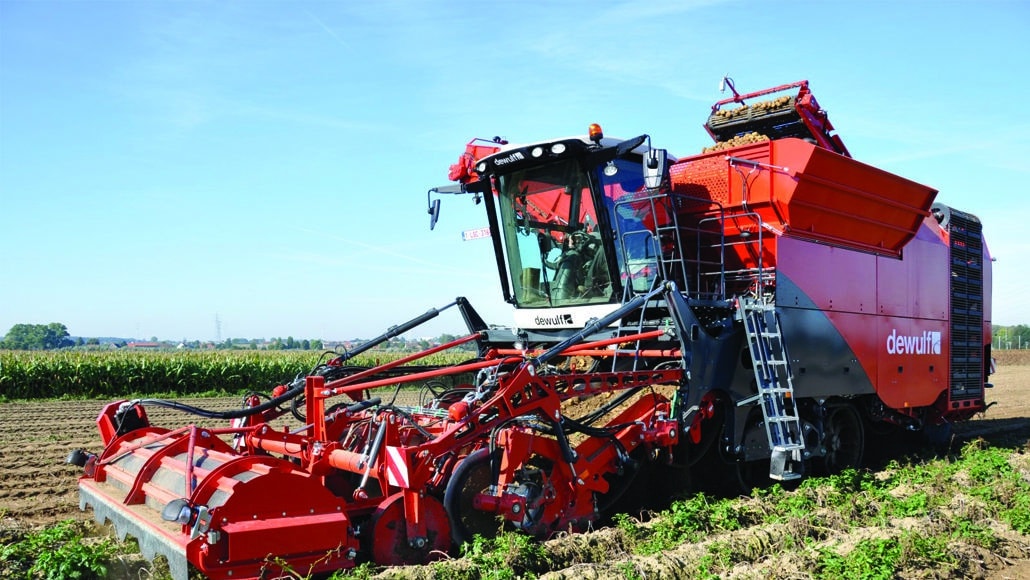[deck]A sampling of some potato equipment on display at the world’s leading exhibition for agricultural machinery.[/deck]
Every two years, Hanover, Germany hosts Agritechnica, the world’s largest trade fair for agricultural machinery and equipment.
Agritechnica 2015 attracted almost 3,000 exhibitors from 50-plus nations along with tens of thousands of visitors from more than 100 countries to Hanover in November. Spud Smart was there and was able to peruse the latest in cutting edge potato equipment on display. Here are some products that caught our eye.
Every-Air Tarp
Winner of a silver medal for innovation at the 2015 Agritechnica, Every-Air is a specialized tarp that’s described as the potato producer’s answer to air distribution problems in box-storages.
Every-Air tarps are long and thin, and are designed to reduce the gap between rows of stacked storage boxes. While the invention is simple, it improves air distribution within box-storages by as much as 300 per cent, according to Hans van den Oever of Mooij Agro, the Dutch manufacturer of Every-Air.
Improved air distribution in storage benefits potato producers in a number of ways. Every-Air tarps, van den Oever says, allow for quicker drying times and more efficient cooling, both of which help to maintain crop quality in storage. He notes additional benefits include a reduction in energy costs and, in cases where CIPC sprout inhibitor applications are used, less sprouting and lower residues.
According to the Mooij Agro website, Winnipeg-based Jeroen van Kappel is the company dealer for Canada. He can be contacted at [email protected].
Kwatro Harvester
One of the modifications is to the Kwatro’s integral haulm chopper, which has been fitted with an improved flail distribution that acts to substantially improve suction. In addition, the hood of the haulm chopper is now made of synthetic material, which eliminates soil clumping.
According to Vandecappelle, the sieving surface has been increased by no less than 11 per cent. “ The Kwatro has a short digger web, followed by two sieving webs,” he says. “Together with the wide and unobstructed flow in the machine, very high driving speeds can be achieved while harvesting.”
Vandecappelle adds there are also now more fixed oil pipes within the machine, which reduces friction between different hydraulic hoses.
The new Kwatro model weighs 15 per cent less than its predecessor and features great weight distribution. This means lower soil pressure and less compaction and a flatter field surface as a result, notes Vandecappelle.
The Dewulf website lists the Canadian distributor for the company’s products as: R&W Equipment Ltd., based in Cookstown, Ontario.

AirSep System
Winner of a gold medal for innovation at Agritechnica 2013, the AirSep system from Spudnik was back on display at the 2015 exhibition.
The new air separation system was developed by Spudnik to separate vines, stones, rocks, clods and other debris in both stand-alone applications and integrated into a potato harvester.
Spudnik offers two-row and three-row harvesters with the AirSep technology. According to Evan Steel, a Spudnik product manager based in Idaho, there’s also a stationary AirSep on the market.
Steel says in his experience, growers most interested in the AirSep technology in harvesters usually farm on rocky soils and are very concerned about bruising. Steel adds he’s sold the most harvester units in Maine, Ontario, Prince Edward Island and New Brunswick.
Most separation systems lift potatoes through suction, leaving the rocks to continue on through the machine. This process takes a lot of horsepower and usually requires a separate motor, explains Steel. In the AirSep system, potatoes are separated from rocks and clods by being blown upwards, which reduces the amount of power required and the need for another motor, he says.
Steel adds there’s also less bruising because of the strategic positioning of the air separator unit within the AirSep harvesters that results in rocks being removed earlier in the process.
“Most growers here in North America are given an incentive based on the amount of potatoes that they have that are bruise-free,” Steel notes. He adds growers also receive incentives for having less foreign material in their product, another area where AirSep technology is particularly beneficial for potato producers.
Steel says that in North America, the hottest AirSep item isn’t the harvester, though — at least, not yet — it’s the stationary unit. But while the harvester is expensive and might seem daunting to use, he still thinks more producers will make the shift in the future, especially once growers see its benefits.
The next Agritechnica trade fair will take place in Hanover in November, 2017.
WHERE ON THE WEB
For a rundown on all the exhibitors at Agritechnica 2015, visit agritechnica.com.











